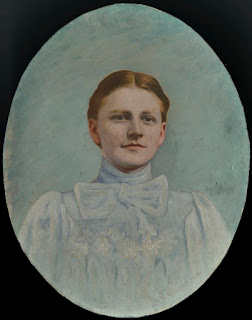William Randall (1860-1905) only spent a short time on the campus of the State Normal and Industrial College, now The University of North Carolina at Greensboro (UNCG), but while he was at the school he created portraits of some of the most important people of the college and the state. Randall’s early life in the mountains of Burke County, North Carolina spanned the years of the Civil War. At a young age he showed a precocious talent for drawing, but had little training. He attended school sporadically and made extra money sketching portraits of his Burke County neighbors.
Committed to furthering his education, he walked out of the mountains and arrived at the University of North Carolina in the fall of 1880 with 30 cents to his name. At the University, he began to draw portraits of the people in Chapel Hill, fellow students, and professors. Although he was described as thin, pale, and unassuming, other students took note of him – one of those students was Charles Duncan McIver, founder and first president of the State Normal and Industrial College. After college, he took several positions in local schools and it was at this time that he met his wife, Annie J. Goodloe of Warrenton, North Carolina. Soon he realized that he preferred art to a career in education. He studied in New York, England, France, and Germany and had a studio in the Corcoran Gallery in Washington DC, specializing in portraiture.
Randall’s path would cross that of McIver once again when his wife, Annie, took a job at the State Normal and Industrial College in 1898 as the school Registrar. Randall had completed a few paintings for the college and he soon had a small studio in the attic of the current Foust Building. He painted several notable people who had a direct impact on the school; including a life-size portrait of McIver.
In addition to his many commissions, Randall worked with the students. Several years after he arrived on campus, he offered to set up a full art program at the college, but there is no indication that his offer was accepted. This may be because of general ill health. Randall had been diagnosed with tuberculosis at a young age and it was about this time that he was sent to New Mexico for the beneficial climate. Randall rented a small adobe house on the outskirts of the city and planned to use it as a residence and studio but he soon returned to North Carolina. On December 11, 1905, he died at Blowing Rock and his body was taken to Washington DC for burial in Glenwood Cemetery.
Ultimately, Randall’s legacy is not only as one of the most famous 19th century North Carolina portrait artists, but also as an early advocate of the importance of formative art (architecture, sculpture, and painting) to a liberal education. On June 23, 1896, he gave an address on the subject before the North Carolina Teachers’ Assembly in Asheville. Interestingly, Randall’s speech included his belief that women had a more highly developed sense of color and felt it was possible that the “early man” who attempted to “imitate” the world around them through painted images – may have actually been early woman. He was committed to the equality of arts and sciences within the liberal arts curriculum and this may have been one of the reasons that McIver found him a kindred spirit.
Sadly, few of Randall’s painting survive on the UNCG campus. Through the years, they have been donated to other institutions or lost as original school buildings were razed or remodeled. Life-size portraits of Charles Duncan McIver and Jabez Curry remain on campus, exhibited in the Curry Building Auditorium. Additionally, his beautiful painting of Lula Martin McIver can be viewed at the Alumni House on College Avenue. Portraits of Sarah and Evelyn Bailey (students who succumbed to the 1899 typhoid epidemic) and philanthropist George Peabody are housed at the University Archives and may be viewed by appointment.
By Kathelene McCarty Smith


